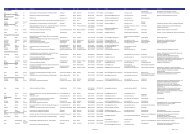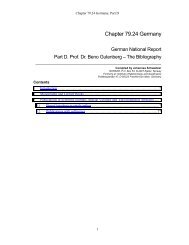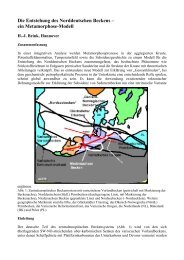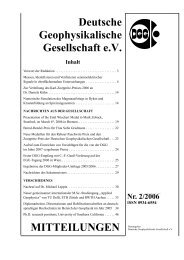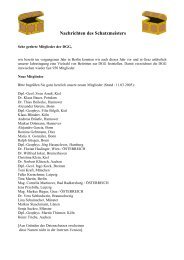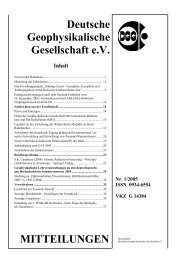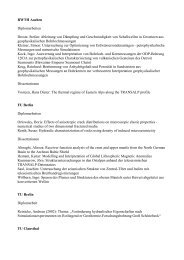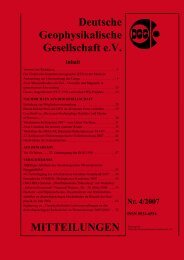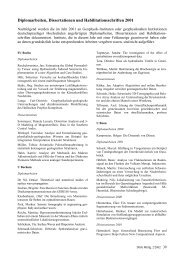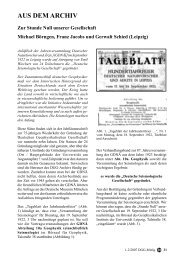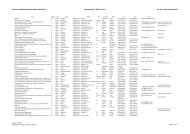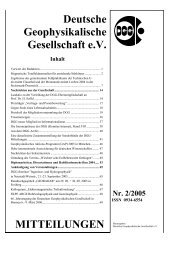Early Contributions to Modern Seismology - Deutsche ...
Early Contributions to Modern Seismology - Deutsche ...
Early Contributions to Modern Seismology - Deutsche ...
You also want an ePaper? Increase the reach of your titles
YUMPU automatically turns print PDFs into web optimized ePapers that Google loves.
a paper in which he claimed <strong>to</strong> have observed and modeled the Earth’s core by delayed P<br />
phase observations (Oldham, 1906). Oldham himself was not very convinced by his P<br />
observations because of their scatter. More important for his argument was the delay of S<br />
phase observations at distances beyond 120°. As Wiechert pointed out in his 1907 paper,<br />
Oldham’s delayed S-phase observations are mostly SS phases, i.e. the reflections of S phases<br />
at the Earth’s surface. This argument was later accepted and published by Oldham himself<br />
(Oldham, 1919). However, one can conclude that Oldham discovered and published about the<br />
shadow effect of the Earth’s core for the first time, but misinterpreted seismic phases and<br />
failed <strong>to</strong> model the core depth and the seismic velocities outside and inside the core.<br />
In Göttingen, the seismologists worked hard <strong>to</strong> derive a reliable travel-time curve for<br />
distances up <strong>to</strong> 100°, and collected observations of earthquakes from longer distances. As<br />
mentioned before, the Samoa-Observa<strong>to</strong>ry was at the right place for this. With local and<br />
regional observations from Samoa and other stations in south Asia, the seismologists in<br />
Göttingen were able <strong>to</strong> locate large events in the southern Pacific area with a precision good<br />
enough <strong>to</strong> extend the observed travel-time curves derived from observations in Göttingen. In<br />
his paper of 1907, Wiechert mentioned that P phases from events in the Samoa region were<br />
delayed in Göttingen. This was similar <strong>to</strong> the observations of Oldham published one year<br />
earlier (Oldham, 1906). However, Wiechert did not invert these data in<strong>to</strong> a model.<br />
In 1911/1912, the situation was different. The data density was much higher, especially<br />
the Samoa data (Wegener, 1912), a method used <strong>to</strong> extend and confirm observed travel-time<br />
curves by interpreting observed amplitude ratios (P/PP) was developed (Zoeppritz † et al.,<br />
1912), and finally, the Herglotz-Wiechert inversion was ready <strong>to</strong> use.<br />
In 1911, Beno Gutenberg (1889 – 1960, see e.g. Byerly, 1953; Jeffreys, 1960; Richter,<br />
1962; Knopoff, 1998, 1999; Schweitzer, 1989; Kertz, 2002; for his bibliography see Chapter<br />
79.24 Part D on Handbook CD #2 by Schweitzer; Figure 27) finished his Ph.D. about<br />
microseism observations and the possible sources of microseisms in Göttingen (Gutenberg,<br />
1911). He was born in 1889 in Darmstadt and came <strong>to</strong> Wiechert <strong>to</strong> study geophysics in 1908.<br />
After his Ph.D., he continued <strong>to</strong> work in Göttingen until Oc<strong>to</strong>ber 1912. Then he served one<br />
year in the army, and from Oc<strong>to</strong>ber 1913 he was employed at the Central Bureau of the<br />
International Association for <strong>Seismology</strong> (ISA) in Strasbourg. Due <strong>to</strong> World War I, he also<br />
lost his job in Strasbourg in 1918 and became unemployed as a seismologist. Gutenberg<br />
moved back <strong>to</strong> Darmstadt and started <strong>to</strong> work in the small soap fac<strong>to</strong>ry of his father. But his<br />
scientific interests were undimmed and in 1922, he <strong>to</strong>ok the opportunity <strong>to</strong> cooperate with the<br />
Institute of Meteorology and Geophysics at the nearby University of Frankfurt am Main,<br />
where Franz Linke was the Professor of Geophysics and Meteorology. For the next eight<br />
years, he managed the soap fac<strong>to</strong>ry, especially after the death of his farther in 1927. During<br />
the evenings, he worked on geophysics, wrote numerous papers about seismology, meteorology,<br />
geodynamics, and the structure of the Earth. In addition, he wrote three monographs and<br />
published and contributed extensively <strong>to</strong> two famous textbooks on geophysics (Gutenberg,<br />
1926-1929; Gutenberg, 1929-1932). Gutenberg became an extraordinary Professor of<br />
Geophysics at the University of Frankfurt and was responsible for the analysis of the<br />
seismograms from the geophysical and meteorological station, the ‘Taunus-Observa<strong>to</strong>rium’<br />
(Taunus Observa<strong>to</strong>ry) (Figure 28). However, he failed <strong>to</strong> get a permanent position at a<br />
German university. Therefore he accepted in 1930 the chair for geophysics at the California<br />
Institute of Technology in Pasadena, California (see e.g. Goodstein, 1984; Goodstein &<br />
Roberts, 1988). During the following years, Beno Gutenberg established the Seismological<br />
Labora<strong>to</strong>ry (of which he later became direc<strong>to</strong>r) in Pasadena as one of the world’s leading<br />
seismological institutes.<br />
After Gutenberg finished his Ph.D., the problem of the Earth’s core was awaiting him. He<br />
put all of the evidence <strong>to</strong>gether and wrote his most important paper about the velocity<br />
structure of the Earth’s interior (Gutenberg, 1913, 1914). Gutenberg was now able <strong>to</strong> explain<br />
the time delay of the observations beyond about 105° with a reasonable model. He estimated<br />
the radius of Earth’s core as 3480 km, a value with less than one percent difference from<br />
18



